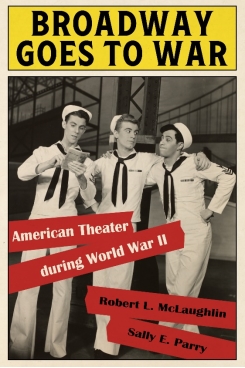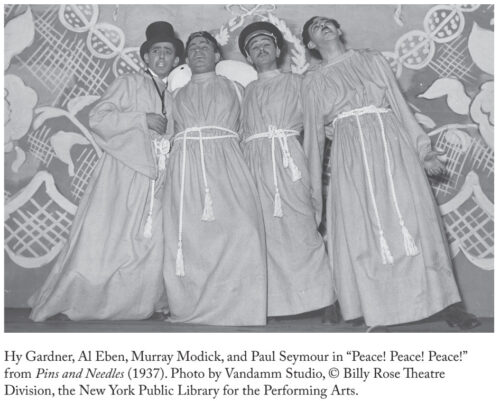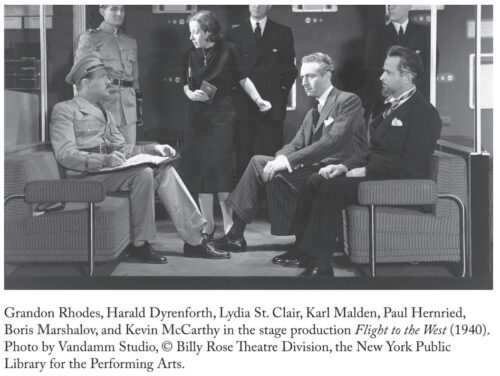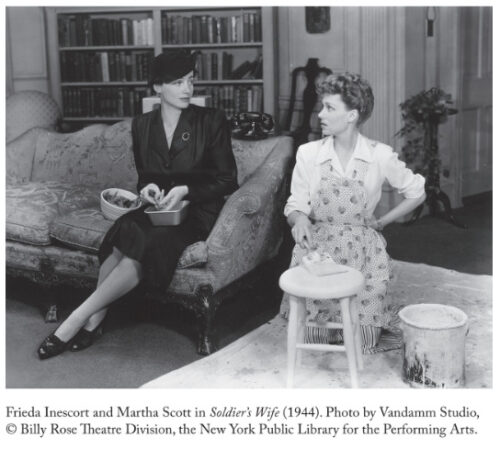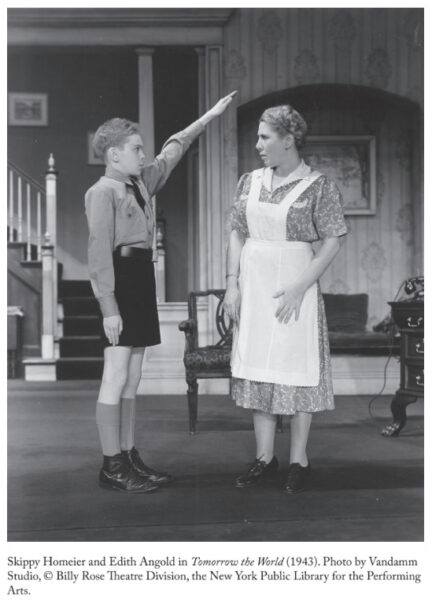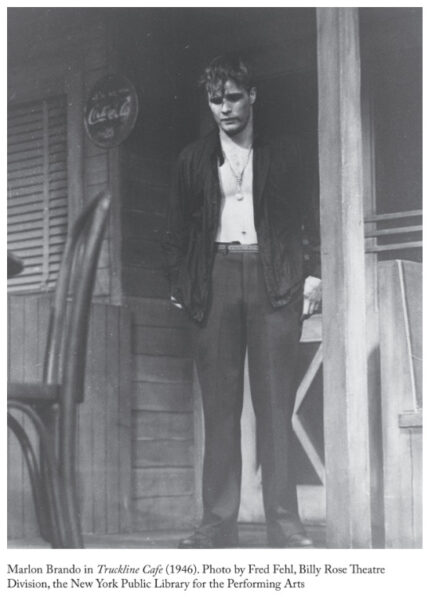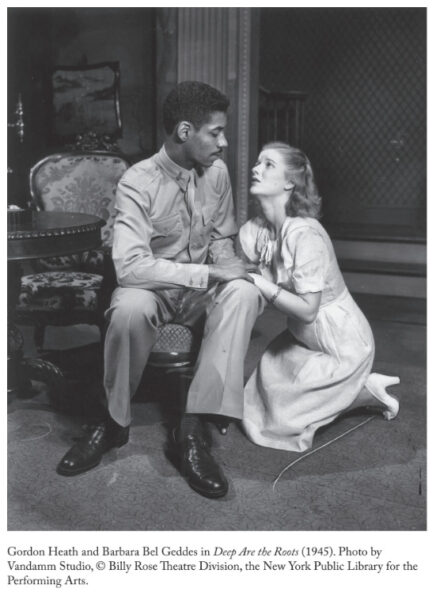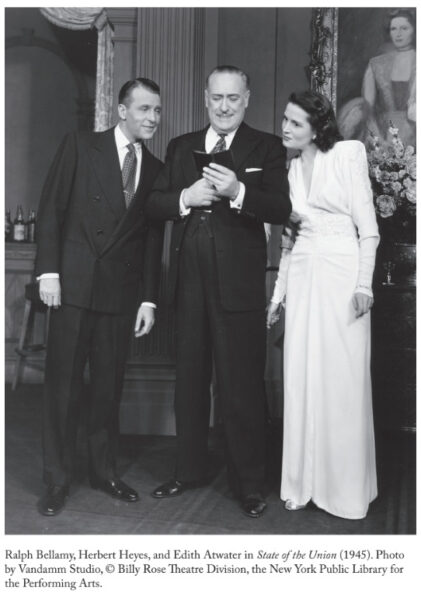THIS MEANS WAR, ER, ENTERTAINMENT
“War, war, war! This war talk’s spoiling all the fun at every party this Spring! I get so bored I could scream!”
That of course is Scarlett O’Hara talking about the Civil War, but the sentiment resonated with a great many Americans in 1939.
As Robert L. McLaughlin and Sally E. Perry explained in their 2006 book We’ll Always Have the Movies: American Cinema During World War II, Hollywood’s wartime films create a false impression of the country’s mood as Europe went to war. The United States are portrayed as united as never before in the face of a common enemy. Typical of this kind of misrepresentation is 1943’s Stage Door Canteen; Katharine Hepburn has only to take isolationist Cheryl Walker firmly by the shoulders, give her a patriotic pep talk, and the war is all but won.
McLaughlin and Perry now give us a companion volume: Broadway Goes to War, American Theater during World War II. In this impeccably researched study we are shown that American theatre of the thirties and forties presented a much more balanced view of the divide in public opinion than the flag-waving Hollywood movies. Clearly, until Pearl Harbor at least half the U S population was on Scarlett O’Hara’s side.
McLaughlin and Perry have studied some two hundred plays and musicals produced on Broadway from 1933 to 1946, all of which contain references to the war. American theatre had acquired a political conscience by the early thirties, and dramatic subject-matter kept pace with political events as Europe was drawn towards war. The plays of the mid thirties deal with the rise to power of Hitler and Mussolini, when fascism was first recognized as a threat to democracy. The left-wing theatre groups led the way here, the political right as usual adopting a head-in-the-sand stance. By the late thirties, when war in Europe was clearly inevitable, writers began to address the issue of what America’s role in the conflict should be, or indeed whether the country should become involved at all. Idiot’s Delight by Robert E. Sherwood is representative of this group.
When America finally entered the war in 1942, writers turned their attention to the effect of war on the men and women in the armed forces, the impact on the home front, and the hot topic of potential enemies within. Lilian Hellman’s Watch on the Rhine belongs in this category. After 1945 a final set of plays address the aftermath of conflict, dealing with the return to civilian life, and anxiety about the nature of the coming post-war world.
All the important dramatists of the day did their patriotic duty and wrote at least one play about America at war. Maxwell Anderson, Robert E. Sherwood, Lilian Hellman, Kaufman and Ferber, Elmer Rice, Philip Barry and Clifford Odets made their contribution. But few of their war plays achieved the success of their greatest work; only Idiot’s Delight, Key Largo, and Watch on the Rhine can truly be said to have survived. Key Largo, recently successfully revived in Los Angeles, lives on as a minor cult film thanks to the presence of Humphrey Bogart and Lauren Bacall. The same might be said of the Idiot’s Delight film, with its troubling glimpse of Clark Gable as a song and dance man.
Of the many long-forgotten plays discussed, the ones inescapably doomed to oblivion are those which unashamedly use the theatre as a platform for political debate. So many of them seem to involve a Nazi, a communist, a capitalist, a Jewish refugee and an idealistic (or disillusioned) American thrown together in unlikely proximity. All too frequently these characters are no more than puppets set up to express opposing views. This was a charge frequently made against serious playwrights of the first half of the twentieth century, the worst offender being George Bernard Shaw, but in his greatest plays Shaw created unforgettable characters to voice his ideas. Pygmalion still delights not as a brilliant study of class barriers (which it is) but because we recognize ourselves in Higgins and Eliza’s spirited wrangling. And who but Shaw could have turned the saintly Joan of Arc into a living, breathing, fallible human being?
McLaughlin and Perry’s argument that Broadway led the way in advocating America’s role in the fight against fascism is seriously undermined by the facts and figures they themselves present. Many of the plays detailed here ran less than a week, at best a month or so. Seen by no more than a few hundred playgoers, did they really have all that much influence on the public mood? No more than a handful have entered the permanent repertoire. Significantly, while the authors assure us that they tracked down and read scripts for almost all of these plays, they don’t appear to have seen a single performance of any of them, and plays only fully come to life on the stage, not on the page.
It’s surely no accident that the book’s cover pictures one of Broadway’s most iconic images, the trio of on-leave sailors in On the Town, a show about getting away from the war, if only for twenty-four hours. Which leads to the conclusion that Broadway’s most important contribution to the war effort was not as a provoker of thought about the war but as a distraction from it. For better or worse, the most successful plays of the time were those which enabled audiences to forget the war; The Man Who came to Dinner and The Philadelphia Story being textbook examples. Such plays as these, more durable than the conscientious diatribes documented here, are outside the scope of this book for the simple reason that they don’t address the war directly, but they are notable as an indication of one of the primary purposes of theatre in wartime. Two other big hits of the time, Blithe Spirit and Arsenic and Old Lace, confront the subject of death head-on, albeit in a tongue-in-cheek way, for an audience that was dealing with death on a daily basis. And Oklahoma! the most influential of the wartime musicals, in portraying an idealized American past, reminded audiences what they were fighting for rather than against.
With all deference to McLaughlin and Perry’s scholarship, and to the many talented writers considered here, the conclusion has to be that Broadway went to war doing what it always did best – it entertained!
© photos from the book for review purposes only, not publicity; do not copy
University Press of Kentucky | 300 pages | English | published on June 8, 2021
available Kindle and Hardcover at Amazon
